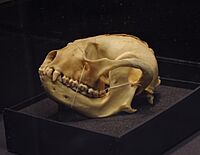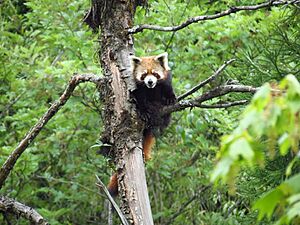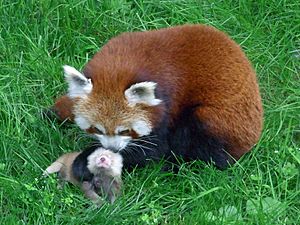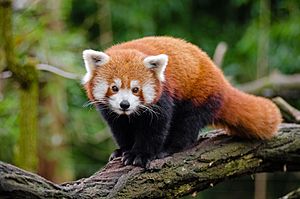Red panda facts for kids
Quick facts for kids Red panda |
|
|---|---|
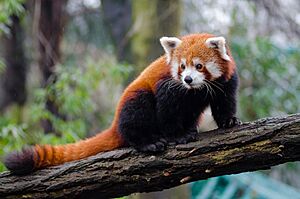 |
|
| Conservation status | |
| Scientific classification | |
| Genus: |
Ailurus
|
| Species: |
fulgens
|
| Subspecies | |
|
A. f. fulgens F. Cuvier, 1825 |
|
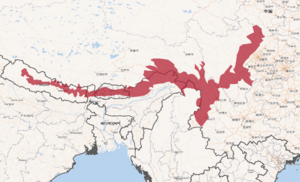 |
|
| Range of the red panda | |
The red panda (Ailurus fulgens), also called the lesser panda, is a small mammal. It lives in the eastern Himalayas and southwestern China. This animal has thick, reddish-brown fur, black legs and belly, and a ringed tail. Its face has white markings around its eyes and ears.
Red pandas are about 51 to 63.5 centimeters (20 to 25 inches) long, not including their tail. Their tail adds another 28 to 48.5 centimeters (11 to 19 inches). They weigh between 3.2 and 15 kilograms (7 to 33 pounds). Red pandas are great climbers. They have flexible joints and curved claws that can partly pull back, like a cat's.
Since 2015, the red panda has been listed as an endangered species by the IUCN Red List. This means it is at high risk of disappearing forever. It is protected in all the countries where it lives.
Contents
- What's in a Name? The Red Panda's Story
- Meet the Red Panda: Appearance and Features
- Where Red Pandas Live: Habitat and Range
- Red Panda Habits: Behavior and Daily Life
- Adaptations
- Lifespan and Diseases
- Why Red Pandas Are in Danger: Threats
- Protecting Red Pandas: Conservation Efforts
- Cool Facts About the Red Panda
- See also
What's in a Name? The Red Panda's Story
The name panda has a bit of a mystery around it. One popular idea is that it comes from the Nepali word "ponya." This word means "ball of the foot" and "claws."
In Nepal, people used to call the red panda "nigalya ponya," which means "bamboo-footed." For over 40 years, the red panda was the only animal known as a "panda." Later, when the giant panda was discovered in 1869, people started calling our furry friend the red panda or lesser panda. This helped tell the two different animals apart.
Meet the Red Panda: Appearance and Features
The red panda's fur is mostly red or orange-brown. Its belly and legs are black. Its muzzle, cheeks, eyebrows, and the inside of its ears are mostly white. The bushy tail has red and light brown rings with a dark brown tip. It also has medium-long whiskers around its mouth, lower jaw, and chin.
Red pandas are about 51 to 63.5 centimeters (20 to 25 inches) long, not including their tail. Their tail is about 28 to 48.5 centimeters (11 to 19 inches) long. Red pandas from the Himalayas usually weigh between 3.2 and 9.4 kilograms (7 to 21 pounds). Chinese red pandas can weigh from 4 to 15 kilograms (9 to 33 pounds) for females and 4.2 to 13.4 kilograms (9 to 30 pounds) for males.
Each foot has five curved toes with curved, semi-retractile claws. These claws help them climb trees easily. Their front paws have a special "false thumb." This is an extra bone in their wrist that helps them grip bamboo stalks. Both their toes and wrist bones are very flexible.
Where Red Pandas Live: Habitat and Range
Red pandas live in several countries. These include Nepal, parts of India (like Sikkim and Arunachal Pradesh), Bhutan, southern Tibet, northern Myanmar, and China's Sichuan and Yunnan provinces.
Their total possible living area is about 47,100 square kilometers (18,200 square miles). This habitat is in the temperate climate of the Himalayas. The average temperature there is between 18 and 24 degrees Celsius (64 to 75 degrees Fahrenheit). They have been found living at heights of 2,000 to 4,300 meters (6,600 to 14,100 feet) above sea level.
| Country | Estimated Size of Habitat |
|---|---|
| Nepal | 22,400 km2 (8,600 sq mi) |
| China | 13,100 km2 (5,100 sq mi) |
| India | 5,700 km2 (2,200 sq mi) |
| Myanmar | 5,000 km2 (1,900 sq mi) |
| Bhutan | 900 km2 (350 sq mi) |
| Total | 47,100 km2 (18,200 sq mi) |
Red pandas live in coniferous forests and temperate broadleaf and mixed forests. They prefer steep areas with lots of bamboo close to water. They usually live alone and spend most of their time in trees.
Red Panda Habits: Behavior and Daily Life
It's hard to watch red pandas in the wild. Most of what we know about their behavior comes from studying them in zoos. Red pandas are active at night and during twilight hours (dawn and dusk). They sleep in between their active periods.
They usually rest or sleep in trees or other high places. When it's hot, they stretch out on a branch with their legs hanging down. When it's cold, they curl up with their tail over their face. They are excellent climbers and can climb down trees head-first. They move quickly on the ground by trotting or bounding.
Living Spaces: Social Behavior
Adult red pandas generally live alone. They are also territorial, meaning they protect their living space. They mark their areas with urine, poop, and special scents from glands near their tail. Males mark their territory more often and for longer periods than females.
What Red Pandas Eat: Diet and Feeding
Red pandas mainly eat bamboo. They also eat fruits, flowers, acorns, eggs, birds, and small mammals. Bamboo leaves are available all year and are often their only food source in winter.
A red panda grabs food with one of its front paws. It usually eats while sitting or standing. They can eat over 1.5 kilograms (3.3 pounds) of fresh leaves or 4 kilograms (8.8 pounds) of fresh bamboo shoots in a single day.
Talking Like a Panda: Communication
Red pandas make at least seven different sounds. These include growls, barks, squeals, hoots, bleats, grunts, and twitters. They growl, bark, grunt, and squeal when they are fighting or chasing each other. They hoot when another red panda comes near them.
Bleating sounds are linked to scent-marking and sniffing. Males might bleat during mating, while females make a twittering sound. When playing or fighting, they arch their backs and tails. They also move their heads up and down slowly. Then they turn their heads, clap their jaws, move their heads sideways, and lift a front paw to strike. They might stand on their back legs, raise their front paws above their head, and pounce. Sometimes, two red pandas will "stare" at each other from a distance.
Reproduction and Life Cycle
Red pandas usually mate between January and March. Babies are born from May to August.
Before giving birth, the female finds a safe den. This could be a hollow tree, a log, a tree stump, or a rock crack. She builds a nest using twigs, sticks, bark, leaves, grass, and moss. A mother red panda usually has one to four cubs. The cubs are born with fur but cannot see.
They depend entirely on their mother for the first three to four months. This is when they first leave the nest. They drink their mother's milk for about five months. Cubs are fully grown around 12 months old. They can have their own babies when they are about 18 months old.
Adaptations
To survive in their special environment, red pandas have developed some amazing adaptations. An adaptation is like a superpower an animal develops over a very long time to help it find food, stay safe, and live comfortably in its home. Let's discover the incredible adaptations of the red panda!
- Red pandas have a thick, reddish-brown fur coat on their backs and sides, which helps them blend in perfectly with the moss and reddish-brown tree bark in their forest homes. This is called camouflage, and it helps them hide from predators like snow leopards or martens, and also helps them sneak up on tasty snacks.
- Their bellies and legs are dark brown or black. This dark color helps them absorb more warmth from the sun, like wearing a dark t-shirt on a sunny day.
- Their fur is incredibly thick and dense, acting like a super warm winter jacket. Even the soles of their paws are covered in fur! This keeps their feet warm and also gives them extra grip when climbing slippery, mossy branches.
- When a red panda is scampering along a narrow tree branch, its long, bushy tail acts like a tightrope walker's pole. It helps them keep their balance, preventing them from falling. This is super important because they spend most of their lives up in the trees.
- The "false thumb" is one of the most unique and coolest adaptations of the red panda. It's not a real thumb like ours, but an extra bone in their wrist that has grown longer and acts like a thumb. Imagine trying to hold a bamboo stalk with just your fingers – tricky, right? The "false thumb" helps red pandas grasp bamboo stalks and leaves firmly, making it much easier to eat their favorite food.
- Red pandas have strong jaws and broad, flat molar teeth (the teeth at the back of their mouth) that are perfect for grinding and crushing the fibrous bamboo stalks and leaves.
- While bamboo makes up most of their diet, red pandas are not only bamboo eaters. They are actually omnivores, meaning they eat both plants and animals. They also munch on fruits, acorns, roots, berries, and sometimes even eggs, insects, or small rodents. This varied diet helps them get all the nutrients they need, especially since bamboo isn't very nutritious on its own.
- Living in trees helps them stay safe from predators that might roam on the forest floor.
- Red pandas are mostly crepuscular, which means they are most active during dawn (early morning) and dusk (early evening). They can also be nocturnal, meaning they are active at night. Being active during these times helps them avoid the hottest parts of the day, especially in warmer seasons. It also helps them avoid some daytime predators and find food when other animals might be less active.
- Red pandas have a relatively slow metabolism, which means their bodies use energy slowly. This is a great adaptation for conserving energy, especially when their main food, bamboo, doesn't provide a huge energy boost.
Lifespan and Diseases
Red pandas can live up to 14 years in zoos. In the wild, they can be hunted by leopards. Red pandas often get sick from tiny living things called parasites. These include protozoa, amoebas, roundworms, trematodes, and tapeworms.
Why Red Pandas Are in Danger: Threats
The biggest threat to red pandas is the loss of their homes. This happens for many reasons. More people living in their areas means more deforestation (cutting down trees). People also illegally take plants and materials from the forest. Herders and their livestock (like cows or goats) also disturb the pandas' habitat.
When livestock walk on the ground, they can stop bamboo from growing. Cutting down all the trees in an area (clearcutting) also makes it harder for some bamboo to grow back.
Poaching (illegal hunting) is another big problem. In southwestern China, red pandas are hunted for their fur. Their bushy tails are especially valuable and are used to make hats. The number of red pandas in China has dropped by 40 percent in the last 50 years. Populations in the western Himalayas are also thought to be small.
Protecting Red Pandas: Conservation Efforts
The red panda is listed in CITES Appendix I. This means it is highly protected, and trading it internationally is usually not allowed. Hunting red pandas is illegal in all the countries where they live.
It has been listed as Endangered on the IUCN Red List since 2008. Experts believe there are only about 10,000 red pandas left in the world, and their numbers are still going down. A large part of their habitat is now protected areas.
Cool Facts About the Red Panda
- Red pandas can walk in snow because they have hair on the soles of their paws.
- Their reddish color helps them hide in trees covered with red moss and white lichen. It's like natural camouflage.
- The red panda's digestive system is only about 4.2 times its body length.
- In China, hats made from red panda tails are sometimes used by newly married couples as a "good-luck charm."
- By the end of 2019, 182 zoos in Europe were home to 407 red pandas.
See also
 In Spanish: Panda rojo para niños
In Spanish: Panda rojo para niños



